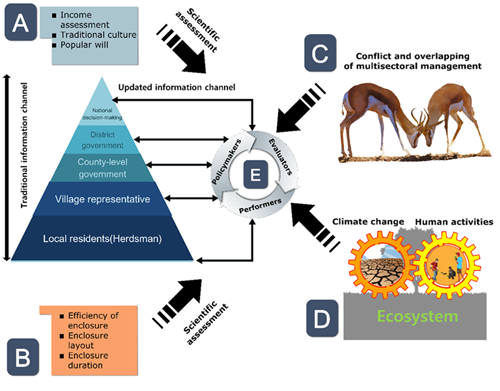A New Study on the Use of Fences for Grazing Exclusion on the Tibetan Plateau
The use of fences for grazing exclusion is a key element of the policy initiative being implemented by the Chinese government to rehabilitate degraded grasslands on the Tibetan Plateau (TP) and elsewhere. Much of the existing research has a limited understanding of the effects of grazing exclusion on alpine ecosystems functions and services, as well as its impacts on herders’ livelihoods.
Consequently, a study about the use of fencing for grazing exclusion on the TP has been conducted using meta-analyses and a household survey in order to evaluate the interaction between fence network nodes and wildlife. A policy framework for the sustainable management of alpine grassland has been developed accordingly. This work is led by Dr. Sun Jian at the Institute of Geographic Sciences and Natural Resources Research, Chinese Academy of Sciences, and involves international collaboration with experts from Australia and Japan.
Meta-analysis indicates that a fencing ban lasting 4 to 8 years can effectively promote the growth of aboveground vegetation in alpine meadow and alpine steppe, while a longer fencing bans do not bring any ecological or economic benefits.
The existence of fencing limits wildlife activities. The TP is inhabited by many wild species including those under national protection, such as the Tibetan antelope. In Northern Tibet, approximately 20% of the sightings of three protected species (wild yak, goa, and Tibetan wild donkey) occurred in fenced areas, indicating that fencing has a direct impact on individuals and populations of these species.
Large-scale fencing networks have prevented wildlife movements and the gene flow, and increased habitat fragmentation, creating challenges to biodiversity conservation on the TP. Responses to the household survey questionnaire revealed that fencing reduces herders’ satisfaction with current grassland management policy. Moreover, installing and maintaining fencing increases the financial burdens on government and conservation expenses.
Given the complexity of the effects fencing has on ecosystem processes, livestock carrying capacity, wildlife habitat, and herders’ livelihoods and culture, the team suggested that further studies, especially long-term field research, are urgently needed.
Based on the results of this recent study, researchers propose the following methods for improving current grassland management policies on the TP: (1) In the case of grasslands that have not been degraded. traditional free grazing is encouraged to maintain or restore traditional grazing practices and culture; (2) in case fencing is necessary, such as in a severely overgrazed area, the use of fencing for limited periods of 4 to 8 years is preferable, and removable fences that can be reused should be deployed; (3) high fence density and connectivity should be avoided, and existing long-term fences should be removed for the benefits of wildlife; and (4) regular and comprehensive assessments are needed to ensure the policy is being effectively managed to deliver benefits in a timely fashion.
This work was supported by the Second Tibetan Plateau Scientific Expedition and Research, and has been published in Science Bulletin (https://www.sciencedirect.com/science/article/pii/S2095927320302607), and commented on in the Editors' choice column of Science (https://science.sciencemag.org/content/368/6494/twil).
 |
| Figure: Scientific grassland management workflows that establish circulatory and long-term mechanisms and comprehensively consider the viewpoints of performers, evaluators, and policymakers. Elements based on local residents (Image by SUN Jian) |
Download attachments: